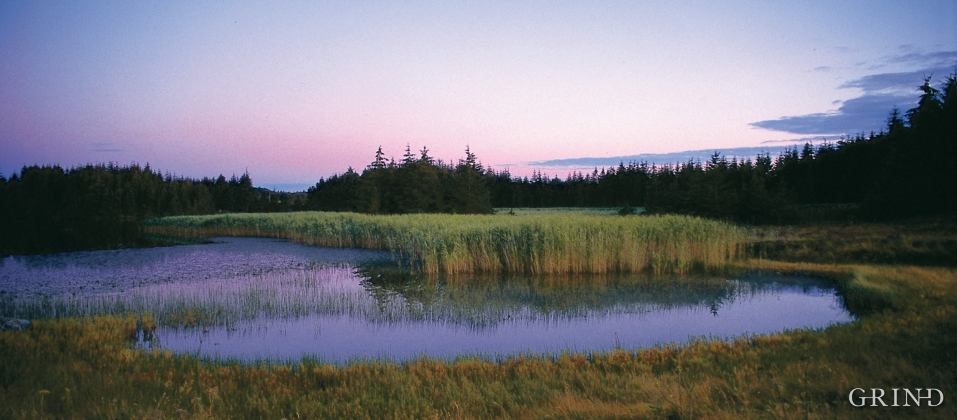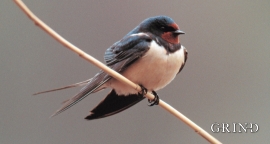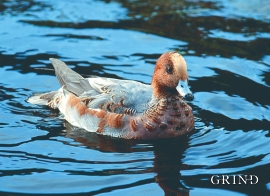Published: 07.08.2015 | Author: Stein Byrkjeland
NIGHTLIFE IN THE SLEEPY CITY
Lake Purkebolsvatnet is perhaps western Norway's largest sleeping city - for birds. They come in the thousands, usually in later summer and autumn. The barn swallows alone number 10 000 - 12 000 at their most numerous.
People tend to retreat to their own space when they want to sleep. Many birds, instead, collect in large flocks - because it is when they are sleeping that they are most vulnerable. One advantage with a "sleeping city" is that they can more easily get news of danger, and they therefore feel more secure about meeting the new day. Probably a communal sleeping place also functions as a kind of information centre. A bird who has had a bad day can easily see who has gained a bit of weight, and may follow them the next morning to ease their task of finding tasty worms to hunt.
It happens during evening twilight. You have surely seen it on nature films from Africa: The birds come in from all directions across the sky, settle in the tree tops or thickets, and gradually quiet down after their violent arguments about who gets the best perch become resolved. This phenomenon is not as obvious at Lake Purkebolsvatnet, but the principle is the same.
The barn swallows are the most numerous, they come in such bands that they are easy to notice. They settle for the night in the dense "forest" of reeds. But, before they retire, many of the swallows have flown about over the water for perhaps an hour catching insects. Sleeping on an empty stomach is not wise for a little bird with a high metabolism. It is hardly imaginable to keep the neighbours awake with tummy rumblings that disturb everyone.
At Lake Purkebolsvatnet it is mostly the year's young swallows who gather, and usually in the weeks before the autumn migrations begin seriously. They come from large parts of South Norway. Local ornithologists have ringed several thousand barn swallows at this locality, and have documented ringed birds from Jæren, Karmøy, Os, Osterøy, Nordfjord, Sunnmøre and Nordmøre. A "flying Dutchman" - a swallow with a ring on its leg from the Netherlands, was documented here on the 22nd of September, 1999. And in Bloemfontein in South Africa, two birds that were ringed at Lake Purkebolsvatnet were observed in August, 2001.
A number of other birds also stay overnight at Lake Purkebolsvatnet. At Lake Klebakkvatnet, just to the south of the swallow-headquarters, probably a couple of hundred Wagtails gather at night. Some Whinchats, Reed Buntings and Starlings also make use of the reeds when evening falls. The dense plots of spruce that were planted around the water provide shelter mostly for crows, but also for some pigeons and Grey Herons.
Lake Purkebolsvatnet has an interesting birdlife the year around, but during the late evening from July to September is the most lively. There are otherwise few places in Hordaland where you find as many gnats as here. Perhaps it is just for this reason that the locality is so popular among the birds.
The myth about the swallos who overwinter at the bottom of the lakes
Already during the Antiquity, the Greeks noticed that flocks of barn swallows gathered by lakes on autumn evenings, and disappeared into the dense forests of reeds. But, as thoughtful and wise people as these were, they did not awaken early enough in the morning to see that the birds then flew away. This is how the myth came to be, that the swallows overwintered at the bottom of lakes.
This ancient hypothesis was actually proven! The Bishop of Uppsala - Olaus Magnus - could in the sixteen hundreds tell of fisherman who drew up nets that were distended with frozen stiff barn swallows. They came to life and flew away when they were brought into the warmth.
Reeds
Reeds are a plant that is widespread in large parts of the world. By Lake Purkebolsvatnet we see perhaps the largest patch of reeds in Hordaland county. The plant thrives best in shallow water with a large supply of organic nutrients, such as from seepage from agriculture. Lakes with reeds are often dominated by one or a few species, but are nonetheless rich bird biotopes.
- Byrkjeland, S.: Grastveit, G.: Reigstad, T. B. ;Svendsen, T. Ornitologiske registreringar ved Purkebolvatnet, Austrheim kommune 1999. Rapport frå Norsk Ornitologisk Forening, avd. Hordaland.
- Håland, A, 1984. Bestandsstørrelse, hekkehabitat og forvaltning av brunnakke Anas penelope på midtre deler av Vestlandet. Vår Fuglefauna 7:3–10.






